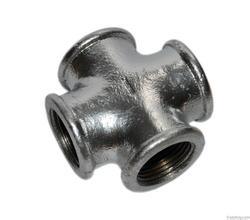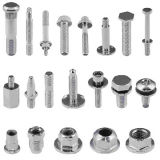| Prod Model: |
JOC 2015 serial |
| Markets: |
North America,South America,Eastern Europe,Southeast Asia,Africa,Oceania,Mid East,Eastern Asia,Western Europe |
| Size: |
1/2"-48" |
| Casting Method: |
Sand Casting |
| Casting Form Material: |
Sand |
| Casting Metal: |
Nonferrous Alloys |
| Casting Form Usage Count: |
Permanent |
Product Description
![]()
![]()
| Material | ASTM A403 WP304/304L, WP316/316L, WP321, WP347, WPS31254, etc. |
| Size | 1/2"-48" (DN15-DN1200) |
| Standard | ANSI B 16.9, JIS, DIN, EN, BS, etc |
| Thickness | Sch5~Sch160, XS, XXS, STD |
| Delivery Time | 25-30 days |
| MOQ | 10 pieces |
| Productivity | 3000000 tons per year |
Pipe fitting is the occupation of installing or repairing piping or tubing systems that convey liquid, gas, and occasionally solid materials. This work involves selecting and preparing pipe or tubing, joining it together by various means, and the location and repair of leaks.
Pipe fitting work is done in many different settings: HVAC, manufacturing, hydraulics, refineries, nuclear-powered Supercarriers and Fast Attack Submarines computer chip fab plants, power plant construction and other steam systems. Pipe fitters (sometimes called simply "fitters") are represented in the USA and Canada by the United Association of Journeymen and Apprentices of the Plumbing and Pipe Fitting Industry of the United States and Canada.
Fitters work with a variety of pipe and tubing materials including several types of steel, copper, iron, aluminium, and plastic. Pipe fitting is not plumbing; the two are related but separate trades. Pipe fitters who specialize in fire prevention are called Sprinklerfitters, another related, but separate trade.
Materials, techniques, and usages vary from country to country as different nations have different standards to install pipe.
Steel pipe[edit]
Steel pipe (or black iron pipe) was once the most popular choice for supply of water and flammable gases. Steel pipe is still used in many homes and businesses to convey natural gas or propane fuel, and is a popular choice in fire sprinkler systems due to its high heat resistance. In commercial buildings, steel pipe is used to convey heating or cooling water to heat exchangers, air handlers, variable air volume (VAV) devices, or other HVAC equipment.
Steel pipe is sometimes joined using threaded connections, where tapered threads (see National Pipe Thread) are cut into the end of the tubing segment, sealant is applied in the form of thread sealing compound or thread seal tape (also known as PTFE or Teflon tape), and it is then threaded into a corresponding threaded fitting using two pipe wrenches. Beyond domestic or light commercial settings, steel pipe is often joined by welding, or by use of mechanical couplings made by companies such as Victaulic or Anvil International (formerly Grinnell) that hold the pipe joint together via a groove pressed or cut (a rarely used older practice), into the ends of the pipes.
Other variations of steel pipe include various stainless steel and chrome alloys. In high-pressure situations these are usually joined by TIG welding.
In Canada, with respect to natural gas (NG) and propane (LP gas), black iron pipe (BIP) is commonly used to connect an appliance to the supply. It must however be marked (either painted yellow or yellow banding attached at certain intervals) and certain restrictions apply to which nominal pipe size (NPS) can be put through walls and buildings. With propane in particular, BIP can be run from an exterior tank (or cylinder) provided it is well protected from the weather, and an anode-type of protection from corrosion is in place when the pipe is to be installed underground.
Copper pipe[edit]
Main article: Copper tubing
Copper tubing is most often used for supply of hot and cold water, and as refrigerant line in HVAC systems. There are two basic types of copper tubing, soft copper and rigid copper. Copper tubing is joined using flare connection, compression connection, or solder. Copper offers a high level of resistance to corrosion, but is becoming very costly.
Soft copper[edit]
Soft (or ductile) copper tubing can be bent easily to travel around obstacles in the path of the tubing. While the work hardening of the drawing process used to size the tubing makes the copper hard/rigid, it is carefully annealed to make it soft again; it is therefore more expensive to produce than non-annealed, rigid copper tubing. It can be joined by any of the three methods used for rigid copper, and it is the only type of copper tubing suitable for flare connections. Soft copper is the most popular choice for refrigerant lines in split-system air conditioners and heat pumps.
Flare connections[edit]
Flare connections require that the end of a tubing section be spread outward in a bell shape using a flare tool. A flare nut then compresses this bell-shaped end onto a male fitting. Flare connections are a labor-intensive method of making connections, but are quite reliable over the course of many years.
Rigid copper[edit]
Rigid copper is a popular choice for water lines. It is joined using a sweat, compression or crimped/pressed connection. Rigid copper, rigid due to the work hardening of the drawing process, cannot be bent and must use elbow fittings to go around corners or around obstacles. If heated and allowed to slowly cool, called annealing, then rigid copper will become soft and can be bent/formed without cracking.
Soldered connections[edit]
Solder fittings are smooth, and easily slip onto the end of a tubing section. The joint is then heated using a torch, and solder is melted into the connection. When the solder cools, it forms a very strong bond which can last for decades. Solder-connected rigid copper is the most popular choice for water supply lines in modern buildings. In situations where many connections must be made at once (such as plumbing of a new building), solder offers much quicker and much less expensive joinery than compression or flare fittings. The term sweating is sometimes used to describe the process of soldering pipes.
Compression connections[edit]
Compression fittings use a soft metal or thermoplastic ring (the compression ring or "ferrule") which is squeezed onto the pipe and into the fitting by a compression nut. The soft metal conforms to the surface of the tubing and the fitting, and creates a seal. Compression connections do not typically have the long life that sweat connections offer, but are advantageous in many cases because they are easy to make using basic tools. A disadvantage in compression connections is that they take longer to make than sweat, and sometimes require retightening over time to stop leaks.
Crimped or pressed connections[edit]
Crimped or pressed connections use special copper fittings which are permanently attached to rigid copper tubing with a powered crimper. The special fittings, manufactured with sealant already inside, slide over the tubing to be connected. Thousands of pounds-force per square inch of pressure are used to deform the fitting and compress the sealant against the inner copper tubing, creating a water tight seal. The advantages of this method are that it should last as long as the tubing, it takes less time to complete than other methods, it is cleaner in both appearance and the materials used to make the connection, and no open flame is used during the connection process. The disadvantages are that the fittings used are harder to find and cost significantly more than sweat type fittings.
Aluminium pipe[edit]
Aluminium is sometimes used due to its low cost, resistance to corrosion and solvents, and its ductility. Aluminium tube is more desirable than steel for the conveyance of flammable solvents, since it cannot create sparks when manipulated. Aluminium tubing can be connected by flare or compression fittings, or it can be welded by the TIG or heliarc processes.
Glass pipe[edit]
Tempered glass pipes are used for specialized applications, such as corrosive liquids, medical or laboratory wastes, or pharmaceutical manufacturing. Connections are generally made using specialized gasket or O-ring fittings.
JOC Machinery Co., Ltd. Was founded in year 2000, specializing in foreign trade of machinery parts and complete sets of equipment. The ranges of products and services covering construction and building machinery, petroleum machinery, mining equipment, power cable production lines, electric power fittings, vehicle and motorcycle parts, industrial vales and etc. Have been exported to more than forty countries and regions of the world.
To better serve customers, stable supply and the quality of the products, we have successively set up three production bases that all certificated with ISO9001 or TS16949: In 2001, the Jiangyin factory was founded, whose main operations are investment casting and CNC machining; In 2005, the Yangzhou factory was founded, whose main operations are steel forging, stamping, fabrication, gravity casting of aluminum and galvanizing finish; In 2011, the Nanjing factory was founded, whose main operations are lost foam iron casting. Furthermore, since 2005 our Jiangyin factory Uni-metals also has established a joint-venture foundry with a British company for automobile turbo charge wheel of vacuum casting, and soon afterwards established 2 branch plants in India and Mexico.
We are committed to team the talents, integrate industry resources, and strive to further develop into a great enterprise of machinery parts and equipment. We look forward to working with you to create a better future.





